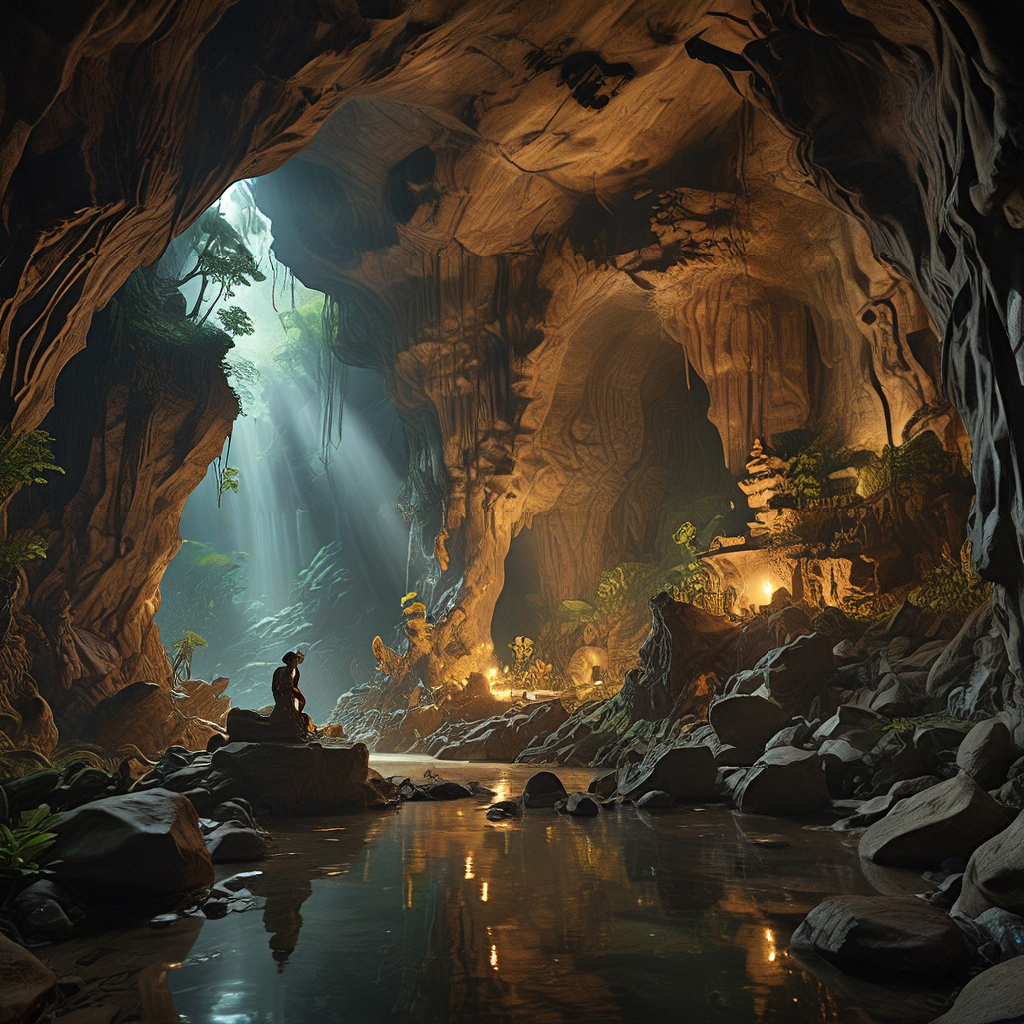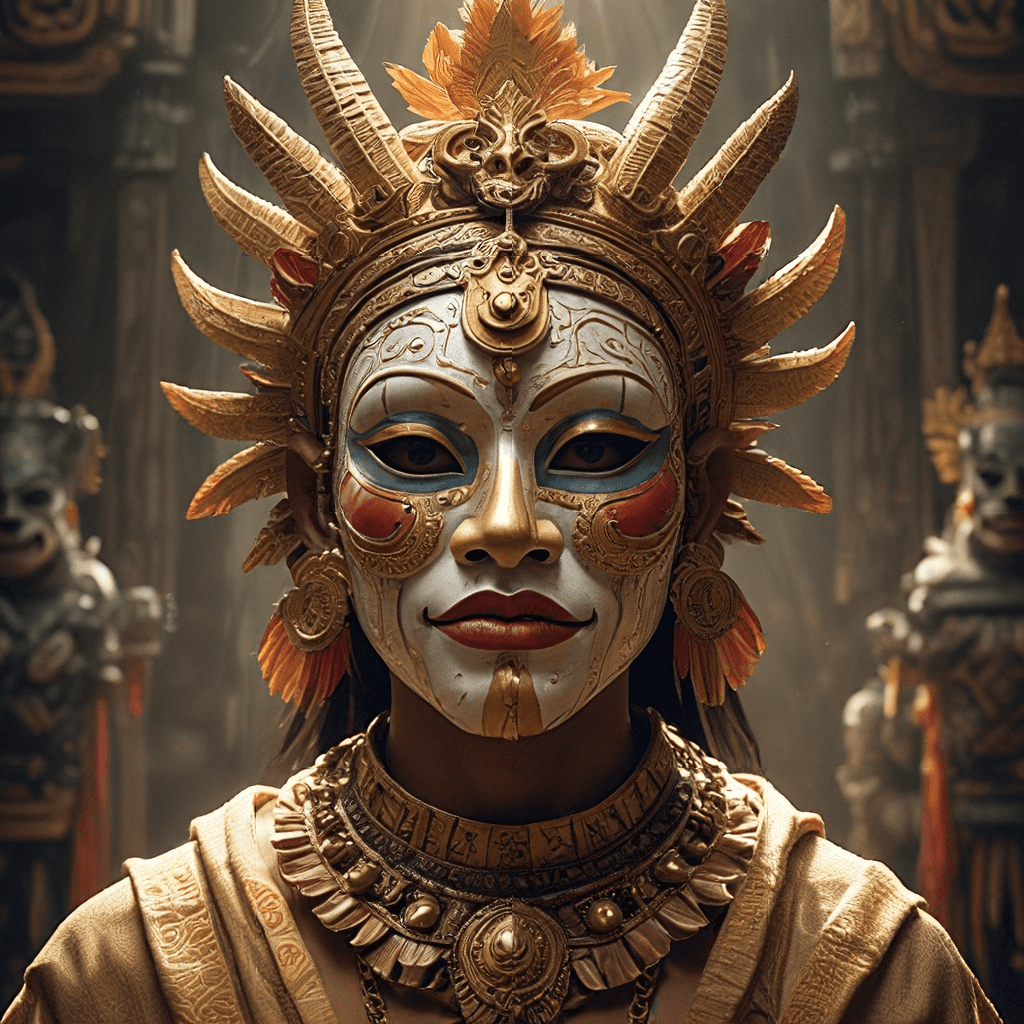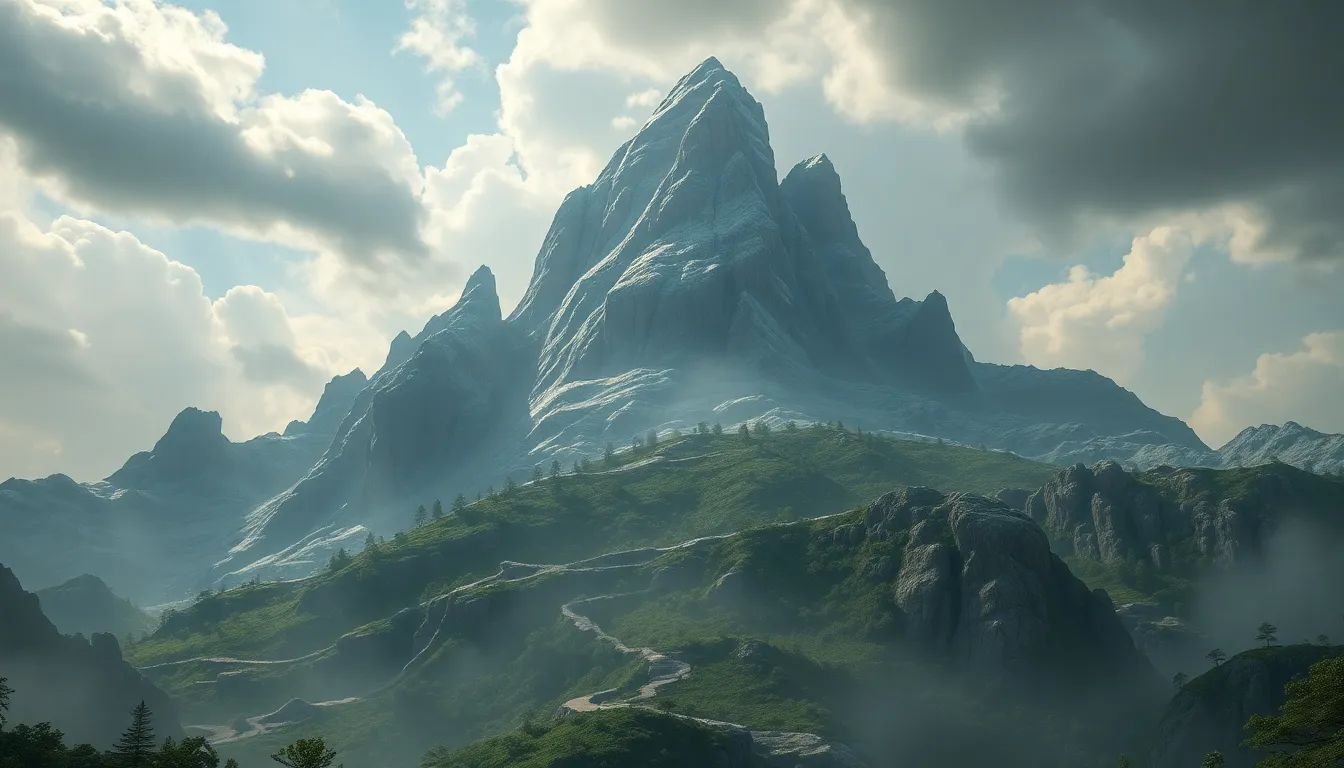Indonesian Caves: Where Myth and Reality Collide
1. Caves as Portals: Connecting the World of the Living and the Dead
Throughout the Indonesian archipelago, caves have long been revered as more than just geological formations. They are portals, symbolic gateways connecting the realms of the living and the dead, a theme echoed in many cultures worldwide. In Indonesian mythology, caves serve as passageways to the underworld, the spirit world, and even to other dimensions.
For example, the myth of Gunung Padang, a massive megalithic site in West Java, tells of a sacred cave leading to the underworld, where the spirits of the ancestors reside. This cave, believed to be the entrance to the "Netherworld", is not merely a physical location but a symbolic passage into the realm of the unseen, where the line between life and death becomes blurred.
The cave also serves as a mystical bridge for communication with the ancestral spirits, allowing the living to seek guidance and wisdom from the other side. These spiritual connections are not restricted to ancestral spirits. Other mythical creatures, such as the "Naga" (serpent-like dragons) and the "Buto Ijo" (green giants), are also associated with caves, further blurring the lines between the natural and the supernatural.
2. Guardians of the Caves: Mythical Creatures and Spirits
The mystical nature of Indonesian caves is further enhanced by the presence of mythical creatures and spirits who are believed to inhabit these shadowy spaces. These guardians of the cave serve as protectors, but also as potential threats to those who dare to enter.
Many Indonesian myths depict caves as home to spirits known as "Hantu", which can take various forms, from mischievous imps to terrifying demons. These spirits are often associated with the natural elements, such as water, fire, or earth, and are said to possess special powers.
More benevolent guardians include the "Dewata", celestial beings who are believed to watch over the caves and their inhabitants. These entities can be appealed to for protection and guidance, and their presence acts as a reminder of the sacredness of these underground realms.
The fearsome "Naga", with their supernatural abilities, are often depicted as guardians of hidden treasures within the caves. These powerful creatures represent both immense power and potential danger, emphasizing the need for respect and caution when approaching these mystical places.
3. The Cave as a Place of Transformation and Initiation
Beyond their symbolic role as portals, Indonesian caves are also seen as places of transformation and initiation. The isolation and darkness of the cave create an environment where individuals can undergo profound spiritual journeys, shedding their old selves and emerging as new, enlightened beings.
The myth of the "Orang Bunian" in Minangkabau culture illustrates this concept. The Orang Bunian, mystical people said to live in hidden caves, are believed to possess special abilities and wisdom. According to folklore, humans who enter these caves might encounter the Orang Bunian and, upon emerging, possess newfound knowledge or healing powers.
This symbolism highlights the transformative power of the cave environment. The darkness and silence of the cave provide a space for introspection, a retreat from the distractions of the external world, allowing for a deep dive into one's inner self.
These transformative journeys often involve trials and tribulations, representing the challenges and obstacles one must overcome to achieve spiritual growth. The cave can be seen as a metaphorical womb, a place of rebirth and renewal, where individuals emerge with a deeper understanding of themselves and their place in the world.
4. Caves as Sites of Hidden Treasures and Knowledge
Indonesian folklore is rich with tales of caves concealing valuable treasures and ancient knowledge, remnants of civilizations long gone. These myths highlight the enduring fascination with the unknown and the power of stories to transmit cultural wisdom across generations.
The myth of the "Kerajaan Bawah Tanah" (Underground Kingdom), often associated with the Gunung Merapi volcano in Java, tells of a hidden kingdom within a cave, protected by magic and mythical creatures. The kingdom is said to possess immense wealth and knowledge, guarded by mystical guardians who only allow those worthy of accessing its secrets.
Similar tales abound throughout the archipelago. Caves are seen as repositories of ancient wisdom, where knowledge from lost civilizations is preserved. This concept extends beyond material treasures. The caves are also seen as repositories of spiritual knowledge, containing secrets about the origins of life, the nature of the universe, and the deeper meaning of existence.
The search for these hidden treasures and knowledge is often symbolic of a quest for self-discovery. It represents the journey to unlock one's potential and access the wisdom that lies within.
5. The Role of Caves in Creation Myths and Origin Stories
The importance of caves in Indonesian mythology extends to the realm of creation myths, where they play a central role in explaining the origins of the world and its inhabitants. These stories offer insights into the cultural values and beliefs that have shaped Indonesian society.
For example, in the myth of the "Batak" people of North Sumatra, the world is said to have been created from a giant egg, which was laid by a mythical bird and hatched in a cave. This story highlights the importance of caves as spaces of birth and creation, where life emerges from the darkness and enters the world.
Other creation myths depict caves as the dwelling places of the first ancestors, who emerged from the earth and populated the land. These stories emphasize the connection between humanity and the natural world, with caves serving as symbolic representations of the womb of the earth, from which all life originates.
These myths highlight the enduring power of the cave as a symbol of mystery, creativity, and the origins of life itself. They offer a framework for understanding the world and humanity's place within it, reminding us of the powerful influence of the natural world on human culture and imagination.
6. Mythical Caves and the Indonesian Archipelago: Regional Variations and Shared Motifs
The Indonesian archipelago, with its diverse islands and cultures, boasts a rich tapestry of cave myths, each reflecting unique local beliefs and traditions. While individual stories vary, certain core themes and motifs resonate across the archipelago, showcasing shared cultural values and beliefs.
In Java, for instance, the "Naga" (serpent-like dragons) are often associated with volcanic caves, guarding sacred springs and ancient treasures. The myths surrounding these creatures reflect a deep respect for nature's power and the importance of maintaining a harmonious balance with the environment.
In Sumatra, the "Orang Bunian" (mystical people) are said to inhabit caves, possessing supernatural abilities and wisdom. These myths highlight the importance of respecting the unseen world and seeking knowledge from those who have mastered its mysteries.
In Bali, cave myths often feature the "Dewata" (celestial beings), who watch over the caves and their inhabitants. These stories emphasize the significance of spiritual connections, seeking guidance from higher powers, and maintaining a balance between the spiritual and secular realms.
Despite these regional variations, Indonesian cave myths share common themes of transformation, initiation, and the interconnectedness of the natural and supernatural worlds. These shared motifs highlight the enduring power of these stories to connect individuals across generations and cultures.
7. Caves in Modern Indonesian Culture: From Folklore to Tourism
Caves have transitioned from being solely mythical realms to becoming popular tourist destinations, with many caves now incorporated into modern Indonesian culture. This shift reflects the growing appreciation for nature and the desire to connect with Indonesia's rich cultural heritage.
The iconic "Goa Pindul" in Yogyakarta, a cave system known for its stunning natural formations and underground river, has become a popular tourist attraction. Similarly, the "Goa Gong" in Pacitan, East Java, famous for its unique acoustics, regularly hosts musical performances, showcasing the blending of myth, nature, and modern entertainment.
Beyond tourism, cave myths continue to influence modern Indonesian art, literature, and music. The mystical and transformative power of caves continues to inspire artists and writers, who explore themes of nature, spirituality, and the human condition.
However, with the rise of tourism and development, there is a growing need to balance access to these natural wonders with the preservation of their cultural and ecological significance. Sustainable tourism strategies and conservation efforts are essential to ensure the continued reverence of these sacred spaces.
8. Interpretations of Cave Mythology: Psychological, Social, and Environmental Perspectives
The enduring appeal of Indonesian cave myths stems from their ability to tap into universal human experiences and anxieties. From a psychological perspective, caves symbolize the unknown and the subconscious, representing the hidden depths of the human psyche.
The fear of the dark, the unknown, and the presence of unseen spirits taps into primal anxieties, while the search for hidden treasures and ancient knowledge reflects the human desire for meaning and purpose.
From a social perspective, cave myths often reinforce community values, traditions, and beliefs. They offer a framework for understanding the world and navigating social interactions, emphasizing the importance of respect for elders, ancestors, and the natural world.
From an environmental perspective, cave myths highlight the interconnectedness of human beings with the natural world. They emphasize the importance of protecting and respecting the environment, recognizing the inherent power and mystery of nature.
These diverse interpretations underscore the complexity and richness of Indonesian cave mythology, revealing its power to transcend individual cultures and address universal human experiences.
9. The Influence of Cave Mythology on Literature, Art, and Music
Indonesian cave myths have inspired artists, writers, and musicians across generations, shaping the artistic landscape through their powerful imagery and evocative narratives. These myths have found expression in various forms, from traditional storytelling and dance to modern novels, paintings, and film.
In literature, authors incorporate cave motifs and characters into their stories, exploring themes of transformation, initiation, and the search for meaning. For example, Pramoedya Ananta Toer's novel "Bumi Manusia" (This Earth of Mankind) features a cave as a symbolic space for introspection and the exploration of identity.
In visual arts, artists create paintings and sculptures that evoke the mystical atmosphere of caves, capturing the interplay of light and shadow, the interplay of the natural and the supernatural, and the timeless beauty of these underground spaces.
In music, composers often draw inspiration from cave myths, creating compositions that reflect the echo of sounds within the cave, the rustling of water, or the presence of spirits.
These artistic expressions demonstrate the enduring influence of Indonesian cave myths, reminding us of their power to inspire imagination, evoke emotions, and contribute to the cultural richness of the nation.
10. The enduring power of cave myths in Indonesian society.
Despite the changes brought about by modernization, Indonesian cave myths continue to resonate with people of all ages and backgrounds. They serve as a powerful reminder of the nation’s rich cultural heritage and the intricate connection between humans and the natural world.
These myths offer a window into the shared values and beliefs that have shaped Indonesian society for centuries, emphasizing respect for ancestors, reverence for nature, and the importance of community.
While modern society may seek to rationalize the world, cave myths continue to hold a special place in the hearts and minds of Indonesians. They offer a sense of wonder, mystery, and a connection to something larger than themselves.
As Indonesian society continues to evolve, these myths will undoubtedly continue to inspire and shape the nation's cultural landscape. They serve as a reminder of the power of storytelling, the importance of preserving cultural traditions, and the enduring fascination with the mysteries that lie beneath the earth's surface.
FAQ
Q: What are some of the most famous caves in Indonesia?
A: Some of the most famous caves in Indonesia include Goa Pindul in Yogyakarta, Goa Gong in Pacitan, and Gunung Padang in West Java. Each of these caves is associated with unique myths and legends and attracts numerous tourists.
Q: How do modern Indonesians view cave myths?
A: While some may view these myths as mere folklore, many Indonesians still hold a deep respect for the stories and the traditions they represent. Cave myths contribute to a sense of identity and connection to the past, reminding them of the cultural richness of their nation.
Q: How do cave myths influence the development of tourism in Indonesia?
A: The captivating nature of cave myths attracts tourists who are eager to explore these mystical places and immerse themselves in Indonesian culture. However, it is important to develop sustainable tourism practices that minimize the impact on the environment and respect the cultural significance of these sacred spaces.
Q: What is the future of cave myths in Indonesian society?
A: Cave myths are likely to continue to hold a significant position in Indonesian society, serving as a source of inspiration for artists, writers, and musicians. They also contribute to the nation's cultural heritage and identity, reminding Indonesians of their unique traditions and their deep connection to the natural world.


